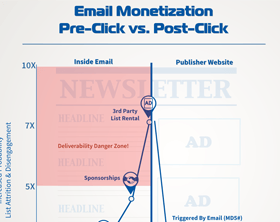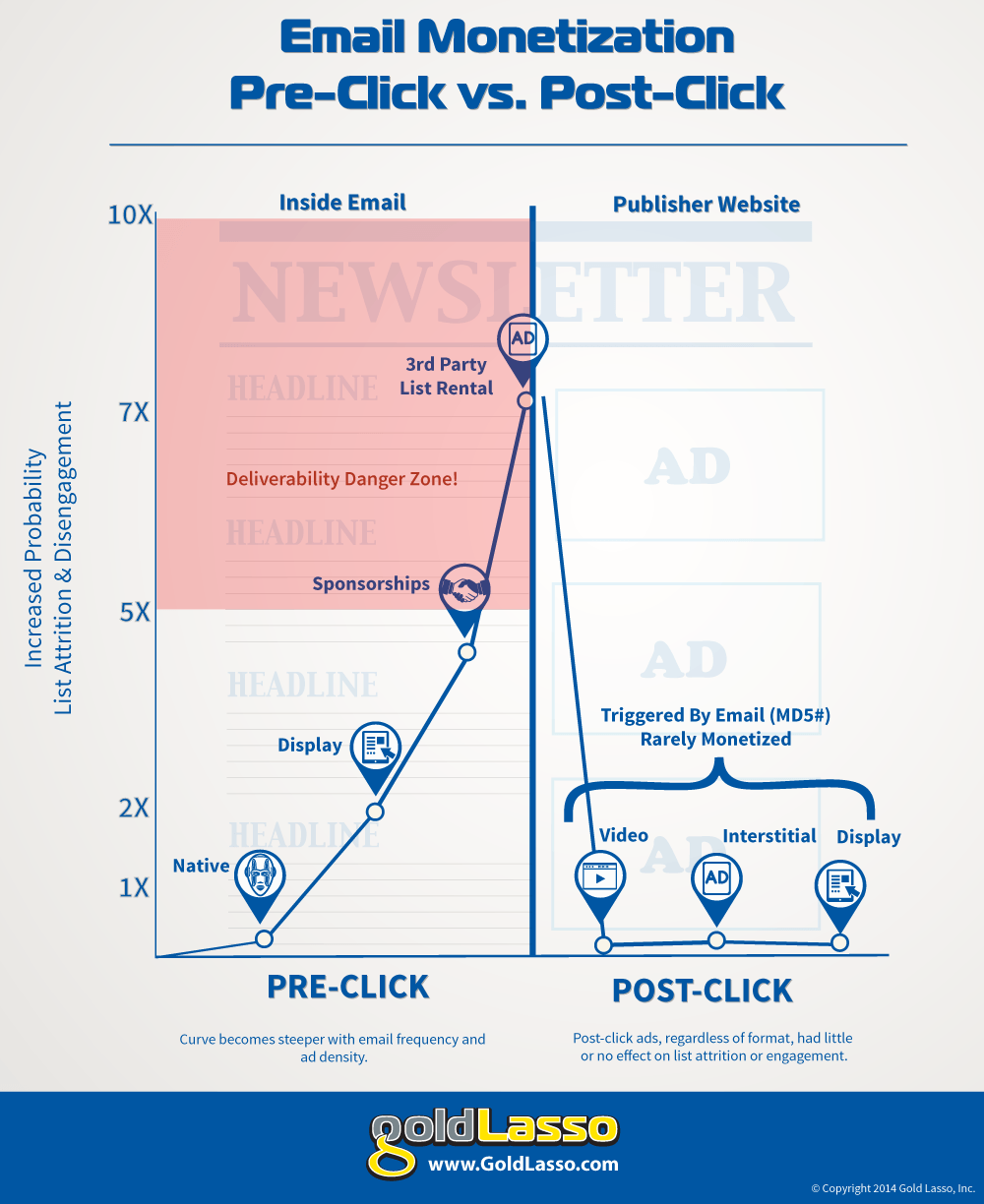The From Line
As published in MediaPost
Email newsletter monetization
When publishers think about email newsletter monetization, the first things that come to mind are usually list rentals, sponsorships, and display ads. While these typical pre-click monetization tactics work well, they often have inherent risks such as subscriber disengagement, list attrition and deliverability issues.
What if there was a more elegant way to monetize email? While most publishers focus on the real estate inside an email for monetization opportunities, they often overlook the most valuable parcels containing complete subscriber attention: the post-click.
Email post-click monetization
Every experienced publisher knows that the actual value of email is not in the opens, but in the clicks. The open statistic is just a prelude to the end goal of focusing a subscriber's attention to valuable content and revenue-producing advertising. Knowing this, nothing is more attention-grabbing than the anticipation of what's on the other side of a click. A quick shot of dopamine commits the subscriber to focus intently on what will happen next. This prime email real estate, the process of going from email to website, the post-click, is what gets squandered the most when publishers monetize email.
Thankfully, there are now targeting methods allowing publishers to monetize this neglected post-click real estate efficiently, without sacrificing list attrition or subscriber engagement. One recent email monetization study by Gold Lasso concluded that most pre-click tactics provide a 2 to 7 times increase in subscriber attrition or disengagement, while post-click tactics have no effect.
Ironically, many of these post-click methods are the same as pre-click (inside the email) but are repurposed for the post-click opportunity. The most prevalent example is leveraging an email address's MD5# or encrypted version. Aside from email marketing, the email address is now serving a multitude of purposes such as creating custom audiences on social networks and providing new revenue opportunities for publishers. Many ad networks now allow publishers to submit an email address's MD5# (instead of a cookie) to return a dynamically created personalized ad. Meaning, everything that you once did inside your email, you can now do outside your email, including video targeting.
Measuring the value of these new email monetization tactics is relatively easy. Basic CPM, CPC, and click-through rates will suffice. Most important, there are no opportunity costs, since most publishers fail to take advantage of email post-click opportunities to begin with.
Measuring the risk associated with these tactics is different. Raw email statistics such as opens, clicks and opt-outs are important, but applying a new combination of ratios can reveal a more telling story. The first new statistic publishers need to be mindful of is the open to click-through rate: that is, the total or unique clicks divided by the total or unique opens (clicks/total opens). If subscribers are conditioned to know they will see an interstitial or targeted ad unit, and are vehemently opposed to the practice, they won't click an email link. If this happens this statistic will fall precipitously, resulting in lower email engagement.
The second statistic is the click to opt-out rate, calculated by dividing the number of opt-outs by the total or unique clicks. If this statistic rises after implementing a post-click monetization program, the increase signifies greater than normal list attrition. To get a better understanding of your program's risk, it is best to compare these statistics to both before and after its implementation.
Despite some initial reservations by publishers, almost all realized that post-click email monetization programs provide new revenue opportunities with minimal risk.
About This Infographic
Do different email monetization tactics affect list attrition and engagement differently? This is what our publishing partners wanted know so we decided to study their monetization practices in detail and some of the results were contrary to typical publisher thinking. We wanted to focus our research on a couple of statistics that could easily be measured but reveal what the true risks of various monetization tactics actually are. Therefore, probability of disengagement and opting out was attributed to subscribers who were exposed to various email monetization tactics. This included over 400,000 randomly selected subscribers across 20 publishing partners employing different and overlapping email monetization tactics. Based on our findings, there’s no surprise that pre-click email monetization tactics (monetization inside an email) significantly increased the probability of list attrition and disengagement.
Native advertising, ads placed in the main content column of an email, had the least effect on attrition and disengagement while 3rd party list rentals increased the probability of a subscriber opting-out or ignoring future messages by over 700%. More importantly, despite the high returns of list rentals, they created dire deliverability issues to future email sent. Contrary to common publisher misconception, however, all post-click email monetization tactics (interstitials, videos, display ads, etc.) that leveraged a subscriber’s encrypted email address for targeting purposes, had very little to no effect on list attrition or disengagement. In other words, publishers who don’t leverage subscriber email addresses for post-click targeting and monetization purposes are leaving low risk to no risk money on the table.
Use This Graphic for FREE on Your Site!
You may use the infographic above on your website, however, the license we grant to you requires that you properly and correctly attribute the work to us with a link back to our website by using the following embed code.
Embed Code
<div>
<a href="/images/easyblog_images/63/Newsletter-Monetization-Curve.png" target=
"_blank"><img src="/images/easyblog_images/63/Newsletter-Monetization-Curve.png" alt=
"infographic" width="430" /><br />
Click to Enlarge</a><br />
Via <a href="/blog/entry/354-infographic-post-click-email-monetization-study">Gold Lasso, Subscriber Engagement & Monetization Systems</a>
</div>
Infographic Thumbnail

There has been talk for years about the Canadian Anti-Spam Legislation (CASL) and when and if it will come to fruition. Well, it looks like it finally has.
The Canadian Anti-Spam Legislation (CASL) will take effect on July 1, 2014. This legislation applies to all email sent from or to Canada. Businesses have a three year grace period (July 1, 2017) to verify and confirm consent to send email to Canadian recipients but can still only communicate with recipients with whom they have an existing business relationship. Any opt-in information you have before CASL comes into force will be recognized as compliant with CASL. You can review the full details of the legislation here.
Given the looming deadline, it is essential for senders to assess their readiness and develop a compliance strategy for this new legislation. Here are some provisions that should be thoroughly investigated:
-
Permission – CASL has an explicit permission provision. This means that implied consent is NOT acceptable for gathering permission. There are multiple exceptions to the rule, including existing business relationships. Purchases qualify for this exception and the 24-month clock resets with every purchase.
-
Implied consent – There are multiple ways where a sender can obtain consent outside the required express consent. Personal or family relationships, inquiries, and several others.
-
The law applies to email that is accessed on computers in Canada.
-
Very different from CAN-SPAM, this is not an opt-out, but an opt-in law. Allowing people the opportunity to opt-out does NOT satisfy the requirements. A pre-checked box is an implied consent method that WILL NOT be allowed. Auto opting-in abandoned shopping carts and e-receipts for promotional mail will also be outlawed.
-
Private right of action – One of the most talked about pieces of this legislation which allows individuals to bring suit, will not take effect until July 1, 2017.
-
3 year transition period – Senders have a 3 year grace period to gain consent of individuals. Implied consent is sufficient during this period, but express consent must be gained to go forward after that period.
- You should update your privacy policy, make sure you are recording consent for proof, and always have a working unsubscribe mechanism.
Ask your ESP to help you identify all Canadian subscribers so you can come up with a plan to re-permission them if needed.
The power of conversion lies in several factors such as the overall look of your site, the content, and the user-friendliness for your visitors. Here are some conversion tips that you may find useful.
Take a walk in their shoes: Pretend you are a customer on your own website. How will you navigate the site and will you know where to go to? Can you easily find what you are looking for? Think like a customer and try it on your website. This can help improve the overall user rating for your website and convert visitors to buyers. If customers feel comfortable with their user experience, they are likely to engage deeper and return after their initial visit.
Content is king: Conversions have a lot to do with quality content on your website. Your articles must be engaging. It you have to make it controversial or funny to attract attention, then by all means do so. There should also be a call-to-action button on your website so that visitors can become customers.
Check out your competition: Keep your competition close by checking them out. Sometimes, you can pick up a lesson or two from them and incorporate it into your website. It does not hurt to research the competition. You have to be on top of your game and keeping an eye out for changes in the competition is a normal thing to do. Check out the strategies they are using and devise your own plan to implement changes accordingly.
Honesty is the best policy: Do not be shady when it comes to your terms and agreement. If you are mining data from your visitors, make sure that it is clearly stated in your Privacy Policy. Once threatened, your visitors will lose faith and likely not return. So it is best to be completely transparent.
Clients that opt-in to receive messages from your company are more likely to be interested in your products. Getting your contacts to agree to receive information from you on a regular basis is the first step in establishing a customer base.
Moreover, Opt-in marketing lists are naturally generated by the intergration of social media networks. Social media has grown into an international platform for business and social exchange. The amount of sales that are generated from social media can determine the success or failure of entire companies.
Companies that build a strong presence in social media are in a perfect position to capitalize on opt-in marketing. Adding an email sign-up box to your social media pages or posting a signup link for your friends can greatly increase the success of your venture. By integrating your opt-in marketing campaign into your social activities, you gain the opportunity to interact with people that are truly interested in your product.
To learn more about how opt-in marketing campaigns can be beneficial to the growth of your company contact us.



